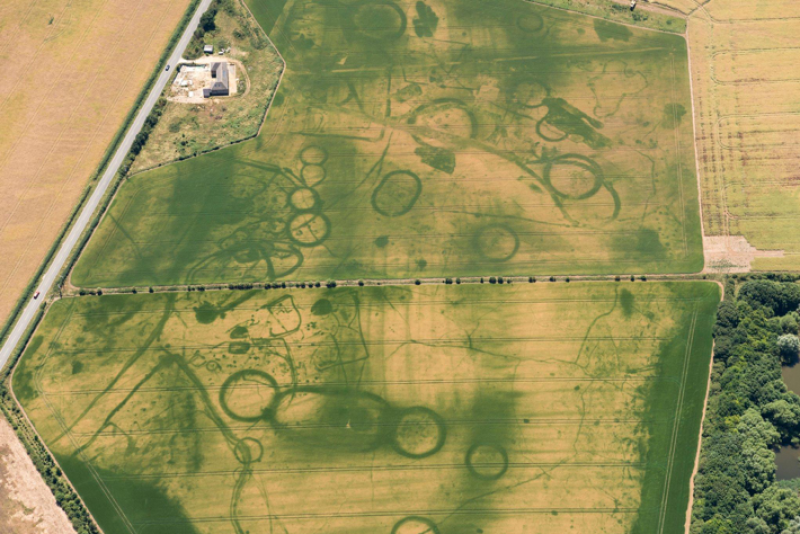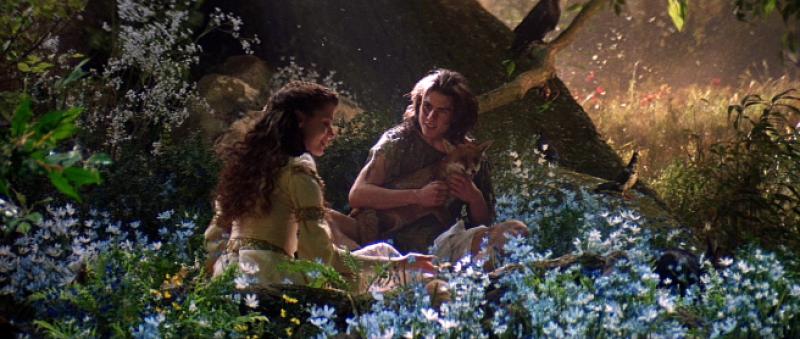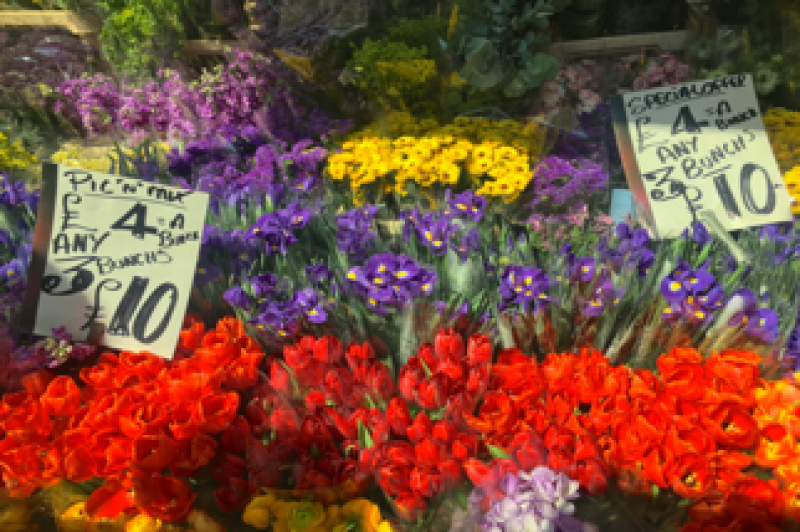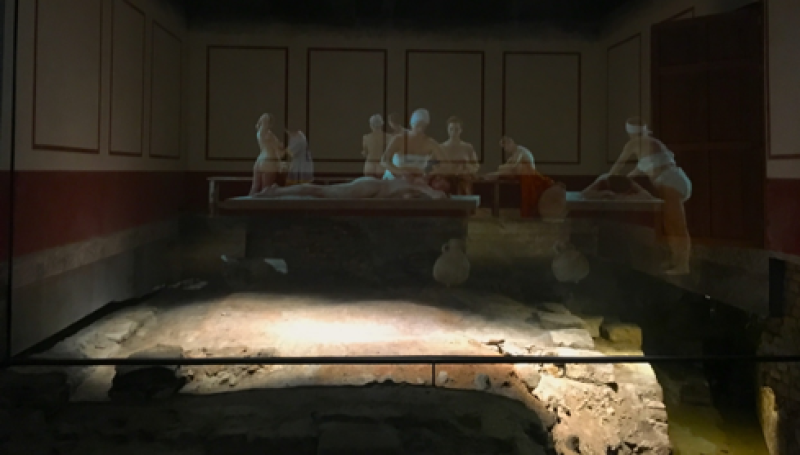Literary London 2018: Victorian Crime and Detective Fiction

The United Kingdom experienced unusually warm weather this summer. Throughout the months of May, June, July and August, the countryside browned beneath the burning, unyielding sun. Metropolitan areas—where interiors traditionally lack air conditioning—became dens of sweat and unholy moisture, such as in London, where the Tube transformed into a massive subterranean steam room.
Flying over the ancient island of Britain, one can clearly see how large swaths of land were carved up and divided by civilizations past. The summer weather provided a visual reminder of this. Primeval scars, such as ditches hewn into the earth by long-dead occupants, remained green and lush as the rest of the rural fields turned golden—a phenomenon known as cropmarks. With visibility at its most extreme since 1976, The New York Times published an article detailing the significance of these markings resurfacing. In the article, Paul M. M. Cooper writes “These lines and rings showed the landscape to be a palimpsest, the page of a book written and erased and rewritten over and over, a mess of crosshatches and scribbles [that] remind us of the complexity of the landscape we inhabit and the overlaying nature of history...In times of turmoil, it has always given us an eerie hope to know that others have come before us, that they disappeared and that the world kept going without them.”

(Above) Aerial photograph of cropmarks, originally published with the referenced NYT article
“Palimpsest” was, ironically, one of the most important terms we learned during our Maymester in London—we referring to the class of approximately twenty students enrolled in the Department of English’s Literature and Cultures of London course, the special topic of which was Victorian crime and detective fiction. The English countryside is an example of a physical palimpsest, but co-teachers Kay Halasek (Associate Professor of English and Director of the University Institute for Teaching and Learning) and Jennifer Schnabel (Assistant Professor and English Subject Librarian) encouraged us to broaden our definitions to include more intangible palimpsests well: the rescripting of myths, stories and even facts. As the class explored subjects like the mythology of Jack the Ripper, the residual legacy of yellow journalism, the use of literary spaces and, of course, the revolutionary Sherlock Holmes stories, we, too, were reminded of the layers of history that settled just so perfectly to bring us to this point in our own histories.
The first thing that struck us about London was the pollen—literally and figuratively. Have you ever seen Ridley Scott’s Legend (1985) starring Tom Cruise? The air in London last May was just like that of the film’s dreamy and vaguely English setting. Pollen, petals and seed pods thickened the air like falling snow. Fluff from the city’s plentiful plane trees caked the sidewalks and gutters. It made everything look and feel slightly smudged, gauzy, as though we were inhabiting someone else’s unfamiliar dream.

(Above) Film still from Ridley Scott's Legend
Although London is often regarded as a city of rain and mist, for most of May it showed its brightest, sunniest face. On the few afternoons it did rain, however, we were struck by how the city seemed to come to life: the streets glossed over, reflecting the shimmering glow of storefronts and traffic lights; street lamps cast a gleam onto the rainswept buildings; the wetness transformed the matte-marble surfaces of the city’s plentiful statues into what looked like a glossy shroud of skin.
During the first of our four weeks in London, our class spent most of our time exploring the city and familiarizing ourselves with our surroundings. Our apartment building—where each of us shared a suite with two to four other Ohio State students—was located not far from the British Library, in the center of a neighborhood filled with hotels and student housing. Coffee shops, pubs and pizza joints peppered the surrounding streets.
Fueled by adrenaline, iced lattes and sheer determination, we began to wander further and further from our home-base into the outskirts of the city, exploring pockets of historically forested areas, such as the notoriously haunted Hampstead Heath. In the Heath, we discovered jewels: a couple of bathing ponds tucked away at the base of a hill. The waters were dark and still, deep and cold—so cold that we could only stand to be in the water for five minutes before we beached ourselves on the dock, gulping warm air through trembling blueberry lips.
Our explorations made it clear that spring was beginning to bleed into summer. All through the city, flowers were blooming pink and yellow and red. Piles of whipped-cream clouds dotted the skies, bright and blue as a robin’s egg. Gurgling fountains, sunlight casting rainbows through the mist, were sprinkled throughout parks and squares. We drank in these sights and ignored our exhaustion, our aching feet. It was worth it.

(Above) One Saturday afternoon, a few of us headed to the Columbia Road Flower Market near Tower Hamlets, a market which sells anything from bright English wildflowers to tropical shrubbery
Class went from 10 a.m. to noon each weekday. All twenty of us would siphon out of our apartment building and walk to the education center through the cool air. To get there, we’d take a path diagonally across Russell Square, which was always bustling with friends getting coffee, parents and toddlers, fellow students and dogs trying to turn the city’s fat, lazy pigeon population into lunch.
The class focused on how the analysis of literary—and literal—spaces could inform our understanding of crime literature from the Victorian era. In a way, Halasek and Schnabel were asking us to engage with the spirits of the nineteenth century by walking the streets they walked, holding the journals they used and reading the words they wrote.
We visited the Dickens Museum, located in a house he once shared with his family not far from our apartment building. It was impossible not to think about the ghosts of the house’s previous tenants as we passed through their bedrooms, filled with furniture they owned, including a close stool toilet (look it up!) and bed frames lacy with cobwebs. If, as Paul M. M. Cooper suggests, the nature of history was overlaid, what separates us from the layers that have come before us? The thin sheen of glamour between their world and ours cannot be so thick and impenetrable as one might think.
The class also covered the works of Wilkie Collins, Arthur Conan-Doyle, Catherine Louise Pirkis and many more. Among other activities, our class visited the major Sherlock Holmes pilgrimage sites, Whitechapel and Highgate Cemetery. We saw three plays, one of which was at Shakespeare's Globe Theatre.
We studied fictional and nonfictional detectives. Following a visit to the Dickens Museum, we read Dickens’ “On Duty with Inspector Field,” which fed into our larger discussion of society’s fascination with crime in general. In the Victorian Era, civilians like Dickens would go on duty with inspectors to get a taste of the city’s criminal underworld. Similarly, they went rabid for trials and executions. In the spirit of this, our class visited the Old Bailey and some of us were able to sit in on the trial for the murder of Sophie Lionnet, a young French nanny who became caught up in her employer’s paranoid folie á deux. The employer and her boyfriend were both found guilty of murder later that month.
Many of us also embarked on our first graduate-level research project, involving a membership to the British Library that allowed us to study centuries-old manuscripts, such as journals handwritten by Arthur Conan Doyle. For some of us, “research” meant sitting in the library and reading a story just like any Victorian would have done on the Tube going to work.
Class assignments—namely homework, group work and projects—were creative. We’d usually read a detective story or two per night and be asked to bring in a notecard each morning with some brisk analysis of one of the settings in the story, like a specific bedroom or a beach. It was particularly special whenever one of these stories was set in London, since we’d be able to analyze spaces that we could visit ourselves. Larger projects asked us to expand on this and incorporate scholarly material and research. In class we’d often share final outcomes of projects; we heard mini-lectures on the Tardis, the growth and development of Soho and Richard III. The class was structured so that we could do research on one subject extensively and then pass on that knowledge to the rest of our peers—collaborative.
We took two weekend trips over the course of the month. The first was to Bath, on the opposite edge of Britain. Our bus gingerly pulled onto cramped, one-way Burton Street and waited while we loaded our baggage; we then began the journey to Bath by way of Stonehenge to the South.
Stonehenge sits on a flat plain of chalk that stretches for 300 square miles. Our bus bounced and bumbled along the road, which cut through rolling hills of rapeseed blooming canary yellow. Flocks of sheep grazed peacefully in the fields; pink pigs dozed in the muddy crevices along the road. As we approached the site, traffic thickened as drivers slowed down to catch a glimpse of Stonehenge from the road.
We took a standing buss from the visitor center to the archaeological site. Stonehenge’s massive, tottering slabs of stone rest heavily on a bed of wild grasses, meadow buttercups and oxeye daisies. The sky was a wooly grey, and the air was heavy with mystery and endless questions: what is this place and why was it constructed? Stonehenge causes the type of frustration you have to force yourself to cut short. The answers to these queries can be found nowhere—that we know of yet.
We grabbed snacks from the visitor center—have you ever tasted a sausage roll? Meat wrapped in flaky, buttery pastry? Our heading was northwest by west toward legendary Bath, whose famous waters have reportedly rejuvenated many a visitor and Georgian heroine for the last few thousand years, ever since the Roman settlement.

(Above) Ghosts haunt the chilly museum built up to surround Aquae Sulis in Bath. Just kidding—they are reimaginings of what activities at the baths would have looked like, projected over the ruins. These translucent, flickering shades are going through the motions of the massage parlour in one of the baths’ hothouses.
The city has been carved out along a valley, with layers of ivory buildings splashing up the hills on either side of the River Avon. Here we visited the Roman Baths, named Aquae Sulis, and the Jane Austen center. We took a day trip to the magnificent Corsham Court, a manor that has been the seat of Saxon kings, the dowery of two of Henry VIII’s wives and, appropriately for us, the location of the International Crime Fiction Association’s annual conference.

(Above) A snapshot of the sprawling estate at Corsham Court. The grounds around the house are filled with magnificent peacocks, whose purpose is to warn inhabitants of intruders
On the third weekend, we took a day trip to Oxford. First, we took a tour of the cavernous, centuries-old Bodleian Library, the filming site for the legendary library of Hogwarts. Following lunch in one of the city’s oldest pubs, we were set loose, free to blend in with the other students. At one point, we were snooping around a church built in the eleventh century and discovered that the building next door, which now houses a Pret A Manger, was previously a brothel. Thus, we encountered yet another example of a physical palimpsest. Oxfordians used to be buying sex after church; now they’re buying a sandwich in between classes. Times change.
Our final week in London rolled over us, initially, in the form of a humid bank holiday weekend. The air was damp and sultry. Then a storm began to brew over Southern England. At first it was nothing but a dark smudge on the horizon. Churning clouds blanketed the city, bringing with them soft, gentle rain. Then the dark sky brightened, and our windows began to shiver as the storm hurled 20,000 bolts of lightning down on London. Somewhere up above the gods were battling.
Our last few days were indulgent ones: an afternoon spent napping in the warm sunlight of Russell Square—tracking down the bakery that made Meghan Markle’s wedding cake and absconding with too many violet buttercream cupcakes. The city was draped in rainbow flags—preparations for Pride Month. We devoured gelato shaped like blooming flowers as well as an increasing amount of iced lattes which fueled our visits to several of the city’s free museums.
We had our farewell dinner at an Indian street food restaurant on the edge of Shoreditch. The following morning, bright and early, our class began to depart. In clumps, we filtered onto the Piccadilly line and hurtled through the darkness of the underground toward a future filled, naturally, with uncertainties. But we were also seized by an eerie hope. Even as we disappeared into the darkness, we were comforted by the knowledge that London would keep going without us.

(Above) The interior of Bath Abbey has been taken over by an art installation – paper butterflies suspended from a net that hangs across the ceiling. We visited multiple churches this weekend with similar installations, including the Salisbury Cathedral where part of the Magna Carta is housed.
By Avery Samuels
